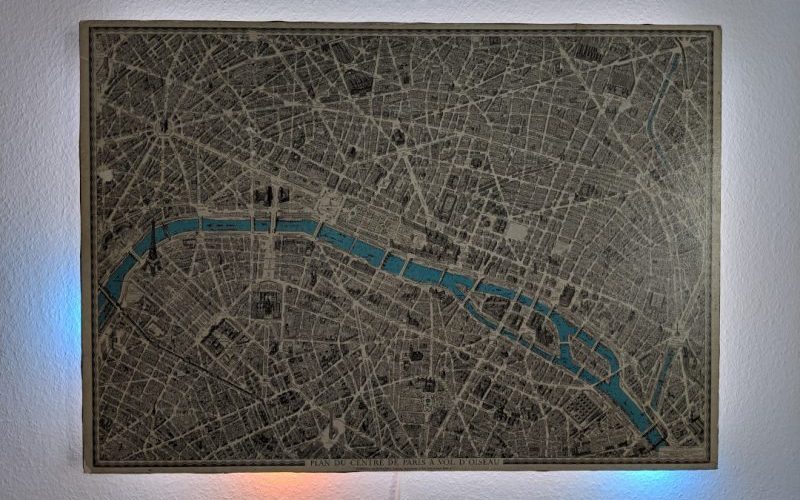There’s plenty to love about antiques, from cars, furniture, to art. While it might be a little bit of survivorship bias, it’s easy to appreciate these older things for superior quality materials, craftsmanship, or even simplicity. They are missing out on all of our modern technology, though, so performing “restomods” on classics is a popular activity nowadays. This antique map of Paris, for example, is made of a beautiful hardwood but has been enhanced by some modern amenities as well.
At first the creator of this project, [Marc], just wanted to give it some ambient lighting, but it eventually progressed over the course of two years to have a series of Neopixels hidden behind it that illuminate according to the current sun and moon positions. The Neopixels get their instructions from an ESP8266 which calculates these positions using code [Marc] wrote himself based on the current date. Due to the limitations of the ESP8266 it’s not particularly precise, but it gets the job done to great effect.
To improve on the accuracy, [Marc] notes that an ESP32 could be used instead, but we can give the ESP8266 a pass for now since the whole project is an excellent art installation even if it is slightly off on its calculations. If you need higher accuracy for tracking celestial objects, you can always grab a Raspberry Pi too.















Take a modern digital map and give it a Victorian era treatment. Then print it on translucent paper to overlay onto a display. Get realtime traffic and other relevant data to underlay the paper map.
I don’t see why using an ESP8266 should necessarily limit the calculations, especially in a way that’s significant to an application like this. Its CPU is plenty powerful. It can get an accurate current time using NTP—one would think that that’s the sole reason for needing Wi-Fi in such an application in the first place.
Marc says (and I’m trying a blockquote tag in a Hackaday comment for the first time—let’s see if it works):
I would think that, to track only the Sun and Moon, and only for the purpose of visualization rather than for telescope aiming, simpler (non-JD-based) math would work well enough, denecessitating double-precision calculations. Is this really not the case? Does [Marc] want it to be able to predict eclipses accurately and autonomously?
And, surely, if double-precision calculations are really needed, they can just be done in software, using a floating point library. Yes, that’s going to be a lot slower, but how frequently do you need to update the bodies’ positions for this application? I bet it would still be able to update them at several Hz or faster. Then just cache the last-calculated LED output signal and repeat it in between calculations, if it’s not already doing that.
Or maybe scrape it from a website somewhere – there are lots of places where this information is available.
Anyone know how the ancient X10 CM11A home automation interface does it? Either via Heyu or X10’s software, the user simply enters a latitude and longitude, and sets the date/time once, and the box automatically executes sun-up and sun-down macros from then on once disconnected from the PC. I’m not sure if it does any serious calculations on the device, or if the PC software just precomputes a whole years worth of on/off times and stores them in the CM11A’s EEPROM, but either way it might be a good reference for how this task here could be done.
The only thing cool about this is the map. The map itself is very cool. It sounded pretty cool in the description, but after viewing the video… it just isn’t.
There’s a great book called “Practical astronomy with your calculator” by Peter Duffett-Smith which would be very useful for the sun/moon calculations if one didn’t want to use a pre-made library
https://archive.org/details/practicalastrono0000duff
> There’s plenty to love about antiques, from cars, furniture, to art. While it might be a little bit of survivorship bias, it’s easy to appreciate these older things for superior quality materials, craftsmanship, or even simplicity.
https://simonsarris.substack.com/p/that-which-is-unique-breaks